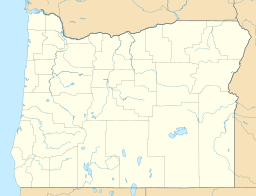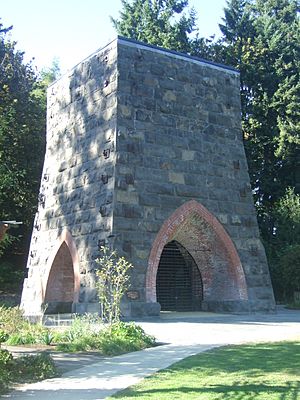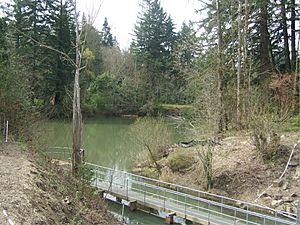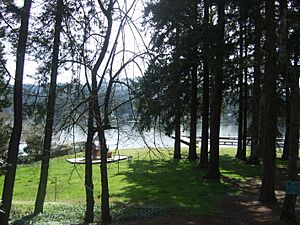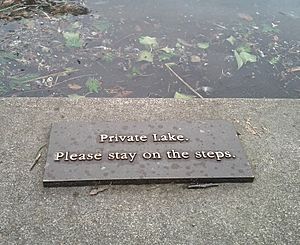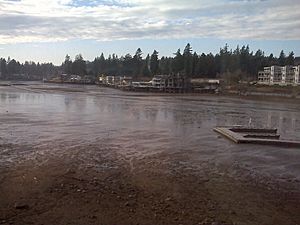Oswego Lake facts for kids
Quick facts for kids Oswego Lake |
|
|---|---|
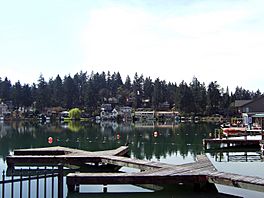
Lakewood Bay (connected to the main lake in 1928)
|
|
| Location | Lake Oswego, Clackamas County, Oregon |
| Coordinates | 45°24′34″N 122°41′47″W / 45.40944°N 122.69639°W |
| Type | Kolk depression/Reservoir |
| Primary inflows | Tualatin River, Springbrook Creek |
| Primary outflows | Willamette River (via Oswego Creek) |
| Catchment area | 6.6 sq mi (17 km2) |
| Basin countries | United States |
| Max. length | 3 mi (4.8 km) |
| Max. width | 0.3 mi (0.48 km) |
| Surface area | 431.7 acres (1.747 km2) |
| Average depth | 26 ft (7.9 m) |
| Max. depth | 55 ft (17 m) |
| Water volume | 10,055 acre⋅ft (12,403,000 m3) |
| Residence time | 2 months |
| Shore length1 | 11.95 mi (19.23 km) |
| Surface elevation | 99 ft (30 m) |
| Islands | Jantzen Island |
| Settlements | Lake Oswego |
| 1 Shore length is not a well-defined measure. | |
Oswego Lake is a beautiful lake located in Clackamas County, Oregon. The entire city of Lake Oswego surrounds it. Even though it started as a natural lake, a concrete dam was built. This dam made the lake much bigger, growing it to about 431.7 acres. The United States Geological Survey officially calls it Lake Oswego. Because its size was increased by humans, it's also known as a reservoir. To avoid confusion with the city, most people still call it Oswego Lake.
Contents
How Oswego Lake Was Formed
Oswego Lake was once a part of the Tualatin River. Over time, the river changed its path, leaving behind this old channel.
About 13,000 to 15,000 years ago, huge floods happened. These were called the Missoula Floods. They were caused when a giant ice dam broke, releasing a massive amount of water. This water rushed down the Columbia River and backed up into the Willamette River. The powerful floodwaters created a swirling underwater current, like a giant drill, called a kolk. This kolk dug out and made the old river channel much larger, forming the natural lake we see today.
Early History of the Lake
The native Clackamas people knew this lake as Waluga. This name meant "wild swan," because they hunted these birds there. When European settlers arrived in the mid-1800s, they called it Sucker Lake. This was because of a type of fish, called a sucker fish, that was common in its waters.
In 1847, a man named Albert Alonzo Durham built a sawmill. It was located on Sucker Creek, which is where the lake's water flows out to the Willamette River. In 1850, he claimed land in the area. He named his new settlement Oswego, after a town in New York.
The Iron Industry in Oswego
In 1865, the Oregon Iron Company was started. Their goal was to make Oswego an important industrial town. The area had a lot of iron ore, which is a rock used to make iron. There were also many trees that could be turned into charcoal to fuel the furnaces.
The company bought the entire town of Oswego, including the lake and the hills around it. The town's population grew quickly. A narrow gauge railroad was built from Portland in 1886, making it easier for people and goods to travel. The iron industry in Oregon was at its busiest around 1890. However, by the early 1900s, it became cheaper to make iron and steel using coke instead of charcoal. This caused the iron industry in Oswego to almost completely stop.
How the Lake Grew Bigger
In 1871, a company started a project to connect the Tualatin River to the Willamette River. They wanted to create a continuous waterway. They planned to build two canals. One canal would connect the Tualatin River to the lake. This would help transport iron from the smelter. The second canal would connect the lake to the Willamette River.
The first canal was finished in 1872. A steamboat called Onward made the first trip through it in 1873. However, another set of locks was completed that made it easier to travel past Willamette Falls. Because of this, the idea for the second canal was dropped.
Wooden dams had been built on Sucker Creek since 1860 to create water power. But these dams would often wash away during winter floods. So, in 1921, a strong concrete dam was built. This new dam provided a steady source of power. It also allowed the lake's water level to be controlled exactly. The water level was raised several feet. This covered up old tree stumps from logging, making the shoreline look much nicer.
People thought the name "Sucker Lake" wasn't very appealing for new residents. So, in 1913, the United States Board on Geographic Names officially renamed it Oswego Lake. Later, in 1961, the USGS changed the official name to "Lake Oswego." However, people usually still use "Oswego Lake" to avoid confusing it with the city's name.
In 1928, a marshy area next to the lake, called the Duck Pond, was flooded. A canal was dug to connect it to the main lake. This created Lakewood Bay. This new area allowed more homes to be built right on the lake, especially near the newly finished Pacific Highway.
Developing the Land Around the Lake
After the iron industry ended, the Oregon Iron & Steel Company focused on developing its land. They owned about 23,000 acres around the lake. In 1909, the company built a power plant. The City of Oswego was officially formed in 1910.
The company's president, William M. Ladd, helped change the iron town. He turned it into a fancy lakeside community. In 1924, Paul Murphy developed the Oswego Lake Country Club. This helped promote Oswego as a place where people could "live where you play."
In 1941, the Oregon Iron and Steel Company created the Lake Oswego Corporation. This corporation still owns the lake today. It is a private company made up of people who own property right on the lake. Owning land right on the lake is very special. Many beautiful homes have been built along its shores. One famous home is the Carl C. Jantzen Estate. It's a large, old-fashioned house built on an island in 1930. The founder of the Jantzen swimwear company built it.
Who Owns and Can Use the Lake?
For many years, the Lake Oswego Corporation has said it owns the lake. They believe they can control who uses it. However, state and local police have recently said they think the lake is public. They have stated they will not charge people for using it. In fact, local police said in 2012 that they might charge the corporation's security guards with unlawful arrest. This would happen if the guards tried to stop swimmers or boaters.
The corporation puts up "no trespassing" signs. They also give out special permits to some people. They also try to control boats, safety, and water quality. But it's not clear if these rules are legally binding for everyone. Most of the land around the lake is privately owned. The Lake Oswego City Council also voted to block entry to the lake from several public parks. This makes it hard for people to test the corporation's rules.
Many times, people have questioned if the corporation can really stop others from using the water. Some legal experts believe the waters are publicly owned. This is based on a 2005 opinion from the Oregon Attorney General. This opinion said that waterways over private land are public if they can be used for public travel.
The corporation argues that a federal law from 1976 said the lake is not a public waterway. So, they say the Attorney General's opinion doesn't apply. They also claim the lake is mostly an artificial reservoir, not a natural body of water.
In 2012, a lawsuit was filed to allow public access to the lake. The case went through several courts. In 2019, the Oregon Supreme Court made a ruling. They said that if Oswego Lake is a public waterway, then the city cannot stop people from entering it from public parks. The case was sent back to a lower court to decide more details.
Lake Health and Maintenance
Sometimes, the Lake Oswego Corporation lowers the lake's water level. This is done by opening the dam. It allows property owners to fix their docks and boathouses. In 2010, the lake was lowered about 24 feet. This was to replace an old sewer pipe that crosses the lake. It was the lowest the lake had been since 1962. The lake was refilled to its normal level in 2011.
In recent years, the lake has had a lot of algae growth. This is partly because of fertilizer runoff from lawns. This runoff contains a lot of phosphorus, which helps algae grow.


